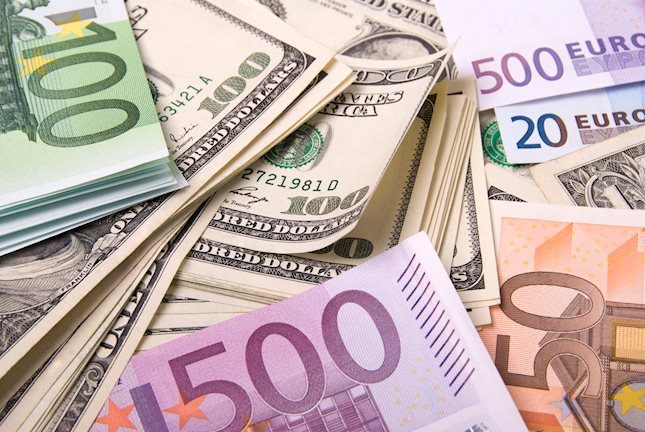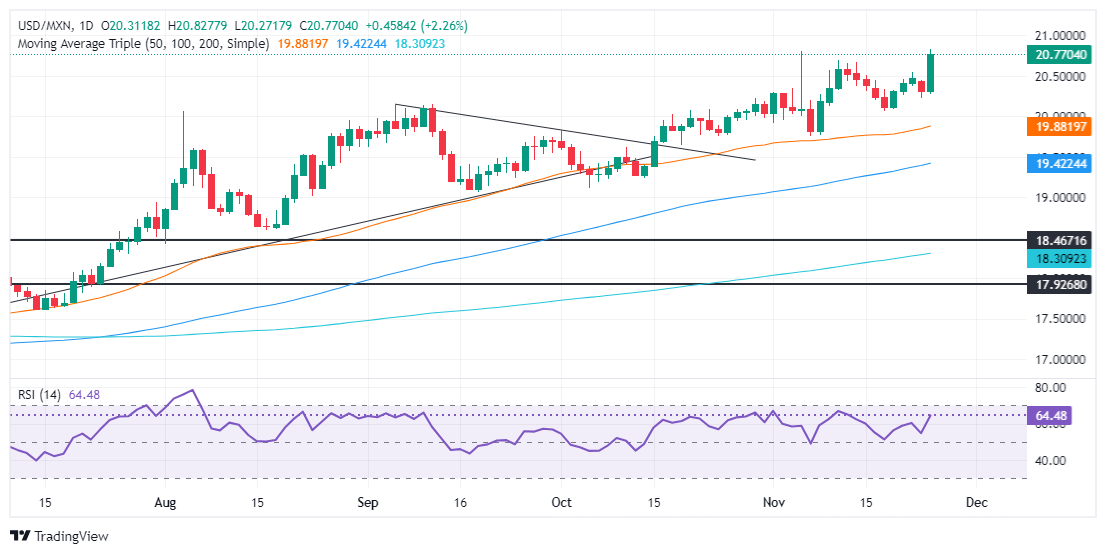- Mexican Peso plunges almost 2% on President-elect Trump’s harsh remarks on tariffs.
- Mexican President Sheinbaum warns of retaliatory tariffs, stressing US consumers could bear the brunt of trade war.
- Banxico's dovish stance and lower inflation expectations hint at further rate cuts, adding pressure to the Peso.
The Mexican Peso collapsed against the Greenback after US President-elect Donald Trump said on Monday that he threatened to impose 25% tariffs on Mexico. Trump blamed the country for not battling drug cartels enough and allowing the passage of illegal immigrants into the US. The USD/MXN trades at 20.67 at the time of writing, gaining almost 2%.
Late on Monday, Trump’s remarks lifted the USD/MXN from around 20.29 to its daily high of 20.74 before retreating somewhat during the European session. Nevertheless, as the North American session kicked in, the Peso remained pressured as the exotic pair advanced toward the 20.70 area.
In response to Trump, Mexican President Claudia Sheinbaum said, “One [US] tariff will be followed by another [from Mexico], and so on until we put common enterprises at risk.” She added, “The main victims will be US consumers” who buy manufactured cars from Mexico.
Aside from this, Mexico’s economic docket remains scarce on Tuesday, but it will feature the release of the Bank of Mexico's (Banxico) latest meeting minutes. Banxico unanimously lowered rates by 25 basis points (bps) on November 14 to 10.25% as expected.
Last week, Banxico Governor Victoria Rodriguez was dovish, hinting that the institution might look to decrease rates by more than 25 bps due to the progress on disinflation. Headline inflation during the first two weeks of November dipped from 4.68% to 4.56% YoY.
In the US, the economic docket revealed that Consumer Confidence improved above estimates and October’s reading. However, traders are awaiting the release of the Federal Reserve’s (Fed) last Meeting Minutes.
Ahead this week, the US economic docket will feature Durable Goods Orders, Initial Jobless Claims, and the Fed’s preferred inflation gauge, the Personal Consumption Expenditures (PCE) Price Index.
Daily digest market movers: Mexican Peso on the defensive amid scarce docket
- Mexico’s Chamber of Deputies, after approving the dissolution of autonomous bodies, proposed adjustments to the details of a contentious reform that abolished several regulatory bodies to ensure compliance with the USMCA trade agreement.
- “The fact that MORENA is taking a more cautious approach with two of the most important regulators, antitrust and telecoms, is a positive sign,” said Rodolfo Ramos of the Brazilian bank Bradesco BBI.
- The Conference Board’s Consumer Confidence for November expanded by 111.7 up from 109.6, exceeding estimates of 111.3
- The CME FedWatch Tool suggests that investors see a 59% chance of a 25-basis-point rate cut at the US central bank’s December meeting, up from 52% a day ago.
- Data from the Chicago Board of Trade, via the December fed funds rate futures contract, shows investors estimate 22 bps of Fed easing by the end of 2024.
USD/MXN technical outlook: Mexican Peso plunges as USD/MXN climbs above 20.70
The USD/MNXN remains upwardly biased and approaches the current day’s peak of 20.76 on Trump’s remarks. A clear break will expose the year-to-date (YTD) high of 20.80, followed by the psychological 21.00 mark. If surpassed, the exchange rate would test the March 8, 2022, peak at 21.46, followed by the November 26, 2021, high at 22.15.
Conversely, if sellers clear 20.50, they would eye the previous year-to-date peak of 20.22. Once taken out, up next would be the 20.00 mark, followed by the November 7 low and the 50-day Simple Moving Average (SMA) around 19.75/86.
Mexican Peso FAQs
The Mexican Peso (MXN) is the most traded currency among its Latin American peers. Its value is broadly determined by the performance of the Mexican economy, the country’s central bank’s policy, the amount of foreign investment in the country and even the levels of remittances sent by Mexicans who live abroad, particularly in the United States. Geopolitical trends can also move MXN: for example, the process of nearshoring – or the decision by some firms to relocate manufacturing capacity and supply chains closer to their home countries – is also seen as a catalyst for the Mexican currency as the country is considered a key manufacturing hub in the American continent. Another catalyst for MXN is Oil prices as Mexico is a key exporter of the commodity.
The main objective of Mexico’s central bank, also known as Banxico, is to maintain inflation at low and stable levels (at or close to its target of 3%, the midpoint in a tolerance band of between 2% and 4%). To this end, the bank sets an appropriate level of interest rates. When inflation is too high, Banxico will attempt to tame it by raising interest rates, making it more expensive for households and businesses to borrow money, thus cooling demand and the overall economy. Higher interest rates are generally positive for the Mexican Peso (MXN) as they lead to higher yields, making the country a more attractive place for investors. On the contrary, lower interest rates tend to weaken MXN.
Macroeconomic data releases are key to assess the state of the economy and can have an impact on the Mexican Peso (MXN) valuation. A strong Mexican economy, based on high economic growth, low unemployment and high confidence is good for MXN. Not only does it attract more foreign investment but it may encourage the Bank of Mexico (Banxico) to increase interest rates, particularly if this strength comes together with elevated inflation. However, if economic data is weak, MXN is likely to depreciate.
As an emerging-market currency, the Mexican Peso (MXN) tends to strive during risk-on periods, or when investors perceive that broader market risks are low and thus are eager to engage with investments that carry a higher risk. Conversely, MXN tends to weaken at times of market turbulence or economic uncertainty as investors tend to sell higher-risk assets and flee to the more-stable safe havens.
Information on these pages contains forward-looking statements that involve risks and uncertainties. Markets and instruments profiled on this page are for informational purposes only and should not in any way come across as a recommendation to buy or sell in these assets. You should do your own thorough research before making any investment decisions. FXStreet does not in any way guarantee that this information is free from mistakes, errors, or material misstatements. It also does not guarantee that this information is of a timely nature. Investing in Open Markets involves a great deal of risk, including the loss of all or a portion of your investment, as well as emotional distress. All risks, losses and costs associated with investing, including total loss of principal, are your responsibility. The views and opinions expressed in this article are those of the authors and do not necessarily reflect the official policy or position of FXStreet nor its advertisers. The author will not be held responsible for information that is found at the end of links posted on this page.
If not otherwise explicitly mentioned in the body of the article, at the time of writing, the author has no position in any stock mentioned in this article and no business relationship with any company mentioned. The author has not received compensation for writing this article, other than from FXStreet.
FXStreet and the author do not provide personalized recommendations. The author makes no representations as to the accuracy, completeness, or suitability of this information. FXStreet and the author will not be liable for any errors, omissions or any losses, injuries or damages arising from this information and its display or use. Errors and omissions excepted.
The author and FXStreet are not registered investment advisors and nothing in this article is intended to be investment advice.
Recommended content
Editors’ Picks

EUR/USD clings to daily gains near 1.0300 after US PMI data
EUR/USD trades in positive territory at around 1.0300 on Friday. The pair breathes a sigh of relief as the US Dollar rally stalls, even as markets stay cautious amid geopolitical risks and Trump's tariff plans. US ISM PMI improved to 49.3 in December, beating expectations.

GBP/USD holds around 1.2400 as the mood improves
GBP/USD preserves its recovery momentum and trades around 1.2400 in the American session on Friday. A broad pullback in the US Dollar allows the pair to find some respite after losing over 1% on Thursday. A better mood limits US Dollar gains.

Gold retreats below $2,650 in quiet end to the week
Gold shed some ground on Friday after rising more than 1% on Thursday. The benchmark 10-year US Treasury bond yield trimmed pre-opening losses and stands at around 4.57%, undermining demand for the bright metal. Market players await next week's first-tier data.

Stellar bulls aim for double-digit rally ahead
Stellar extends its gains, trading above $0.45 on Friday after rallying more than 32% this week. On-chain data indicates further rally as XLM’s Open Interest and Total Value Locked rise. Additionally, the technical outlook suggests a rally continuation projection of further 40% gains.

Week ahead – US NFP to test the markets, Eurozone CPI data also in focus
King Dollar flexes its muscles ahead of Friday’s NFP. Eurozone flash CPI numbers awaited as euro bleeds. Canada’s jobs data to impact bets of a January BoC cut. Australia’s CPI and Japan’s wages also on tap.

Best Forex Brokers with Low Spreads
VERIFIED Low spreads are crucial for reducing trading costs. Explore top Forex brokers offering competitive spreads and high leverage. Compare options for EUR/USD, GBP/USD, USD/JPY, and Gold.
